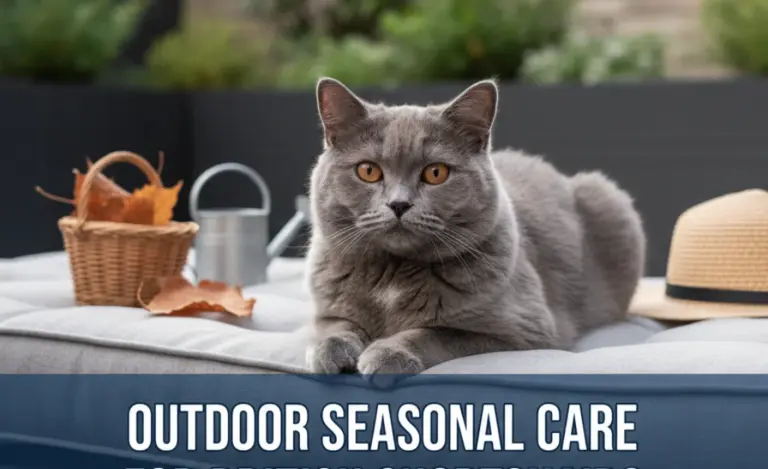Outdoor Water Source Safety for British Shorthairs: Ultimate Guide
To keep your British Shorthair safe around outdoor water, always provide a clean, accessible water bowl inside. Cover or block access to pools, ponds, and water features to prevent accidental falls or ingestion of contaminated water. Regularly check outdoor areas for potential hazards like toxic algae or chemicals. Supervise your cat when outdoors and teach them to avoid unsafe water sources.
Many British Shorthair owners enjoy letting their cats explore the outdoors, whether in a secure garden or on supervised outings. While these adventures can be enriching, they also present potential dangers, especially when it comes to water sources. Ponds, pools, bird baths, and even puddles can pose risks to your furry friend. It’s natural to worry about your cat’s safety, but with the right knowledge and precautions, you can ensure their outdoor experiences are both fun and safe.
In this guide, we’ll explore the common water-related hazards your British Shorthair might encounter outdoors and provide simple, effective steps to protect them. From recognizing the signs of water intoxication to creating a safe outdoor environment, we’ll cover everything you need to know. Let’s dive in and make your garden a safe haven for your beloved British Shorthair.
Why Outdoor Water Sources Can Be Risky for British Shorthairs
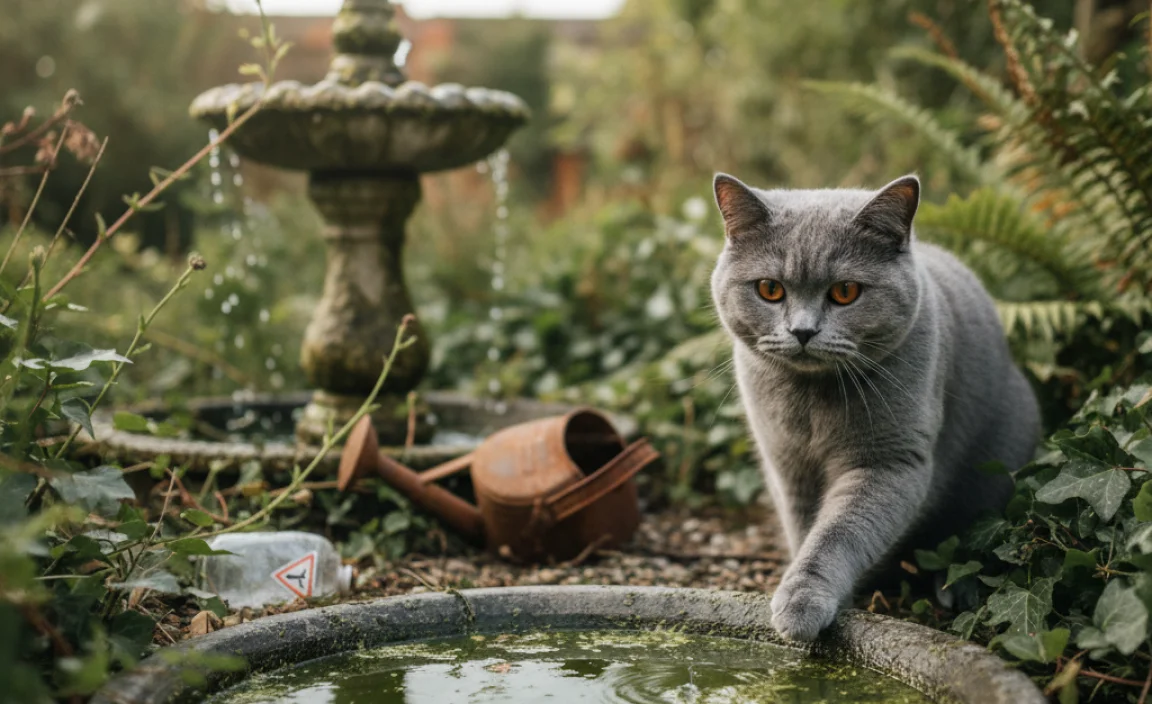
British Shorthairs, with their curious nature, might be tempted to drink from or play in various outdoor water sources. However, these sources often carry hidden dangers that can affect their health and well-being.
Contamination Risks
Outdoor water sources can be contaminated with various harmful substances:
- Bacteria and Parasites: Ponds and puddles can harbor bacteria like E. coli and parasites like Giardia, leading to gastrointestinal issues.
- Chemicals: Runoff from gardens and lawns might contain fertilizers, pesticides, and herbicides, which are toxic to cats if ingested.
- Algae: Blue-green algae (cyanobacteria) in ponds can produce toxins that cause liver damage, neurological problems, and even death. The RSPCA warns about the dangers of blue-green algae to pets.
- Debris: Decaying leaves, insects, and other organic matter can contaminate water, making it unsafe for drinking.
Drowning Hazards
Even shallow water can be a drowning risk for cats:
- Pools: Uncovered swimming pools are a significant hazard. Cats can fall in and struggle to get out, especially if the sides are slippery.
- Ponds: Steep-sided ponds can also be difficult for cats to escape from if they fall in.
- Buckets and Containers: Rainwater collected in buckets or other containers can be a drowning risk, particularly for kittens.
Water Intoxication
Drinking too much water, especially after exercise, can lead to water intoxication (hyponatremia):
- Electrolyte Imbalance: Excessive water dilutes the electrolytes in the blood, leading to neurological symptoms.
- Symptoms: Signs of water intoxication include vomiting, lethargy, dilated pupils, and seizures. If you suspect your cat has water intoxication, seek immediate veterinary attention.
Creating a Safe Outdoor Environment for Your British Shorthair
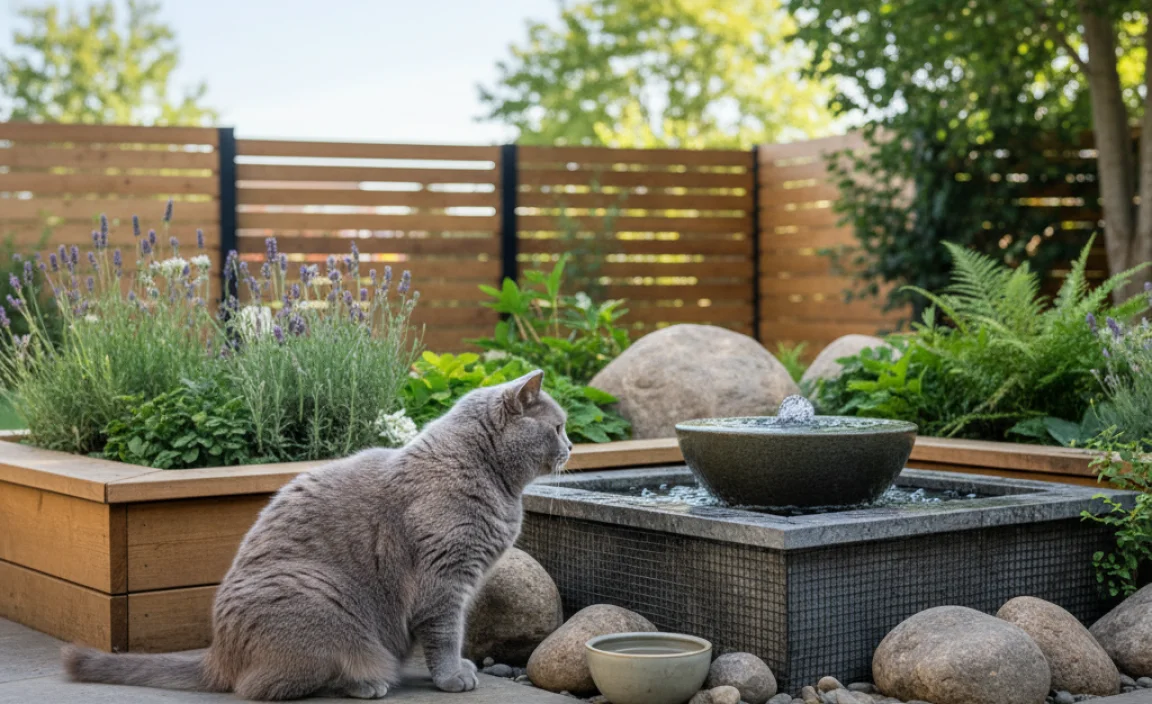
To protect your British Shorthair from these risks, it’s essential to create a safe outdoor environment. Here are practical steps you can take:
1. Provide Fresh, Clean Water
Always ensure your cat has access to a clean, fresh water bowl indoors and, if they spend a lot of time outside, in a safe outdoor location. This will reduce their temptation to drink from potentially contaminated sources.
- Location: Place the water bowl in a shaded area to keep the water cool and fresh.
- Material: Use a ceramic or stainless-steel bowl, as plastic can harbor bacteria.
- Regular Cleaning: Clean and refill the water bowl daily to prevent bacterial growth.
2. Secure or Eliminate Water Hazards
Take steps to minimize or eliminate potential water hazards in your garden:
- Swimming Pools: Cover your pool with a safety cover when not in use. Consider installing a pool fence to prevent access.
- Ponds: Install a fence around the pond or create shallow edges with rocks or plants to allow easy escape if your cat falls in.
- Water Features: Drain or cover small water features like bird baths when not in use.
- Buckets and Containers: Empty any containers that collect rainwater to eliminate drowning risks.
3. Monitor Water Quality
Regularly inspect outdoor water sources for signs of contamination:
- Algae Blooms: Be vigilant for blue-green algae blooms in ponds. These can appear as a green or blue-green scum on the water’s surface.
- Unusual Odors: Check for any unusual odors that could indicate chemical contamination.
- Debris: Remove any decaying organic matter from water sources.
4. Supervise Outdoor Activities
Supervision is key to keeping your British Shorthair safe outdoors:
- Leash Training: Consider leash training your cat to keep them close and prevent them from accessing unsafe areas.
- Outdoor Enclosures: Build or purchase a catio (outdoor enclosure) to provide a safe outdoor space.
- Regular Checks: Regularly check on your cat while they are outside to ensure they are not drinking from or playing in unsafe water sources.
5. Educate Your Cat
While you can’t fully train a cat to avoid water, you can discourage them from drinking from unsafe sources:
- Positive Reinforcement: Reward your cat with treats and praise when they drink from their water bowl.
- Deterrents: Use motion-activated sprinklers or noise-making devices to deter your cat from approaching unsafe water sources.
Recognizing and Responding to Water-Related Issues
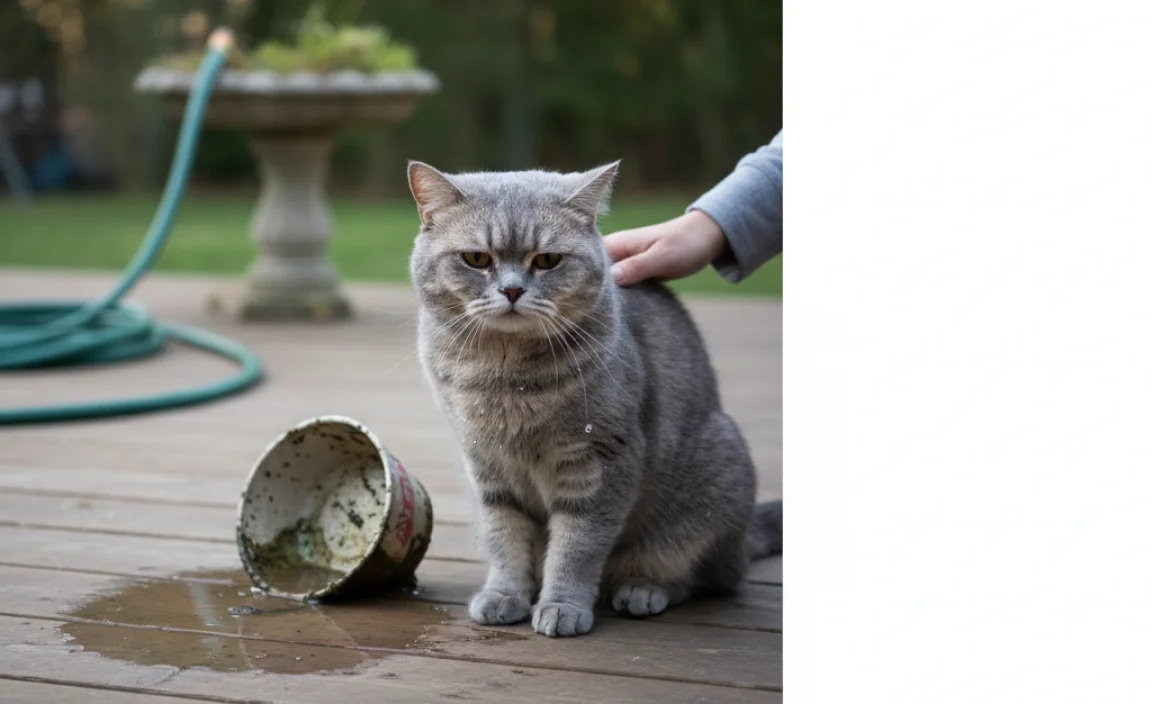
Knowing how to recognize and respond to water-related problems is crucial for your cat’s safety.
Signs of Water Intoxication
If your cat drinks too much water, they may develop water intoxication. Watch for these symptoms:
- Vomiting
- Lethargy
- Dilated pupils
- Excessive drooling
- Loss of coordination
- Seizures
If you notice any of these signs, seek immediate veterinary attention. Water intoxication can be life-threatening if left untreated.
Signs of Poisoning
If your cat has ingested contaminated water, they may show signs of poisoning. These can include:
- Vomiting
- Diarrhea
- Loss of appetite
- Weakness
- Tremors
- Difficulty breathing
Contact your veterinarian or an animal poison control center immediately if you suspect your cat has been poisoned. The ASPCA Animal Poison Control Center is a valuable resource.
First Aid for Drowning
If your cat falls into water and struggles to get out, act quickly:
- Remove Your Cat: Carefully remove your cat from the water, being mindful of your own safety.
- Check for Breathing: Check if your cat is breathing. If not, perform rescue breathing (gently blow into their nose and mouth every 3-5 seconds).
- Clear Airways: Hold your cat upside down to help drain water from their lungs.
- Keep Warm: Wrap your cat in a warm towel and seek immediate veterinary attention. Even if your cat seems fine, they may have inhaled water and could develop pneumonia.
Essential Safety Products for Outdoor Cats
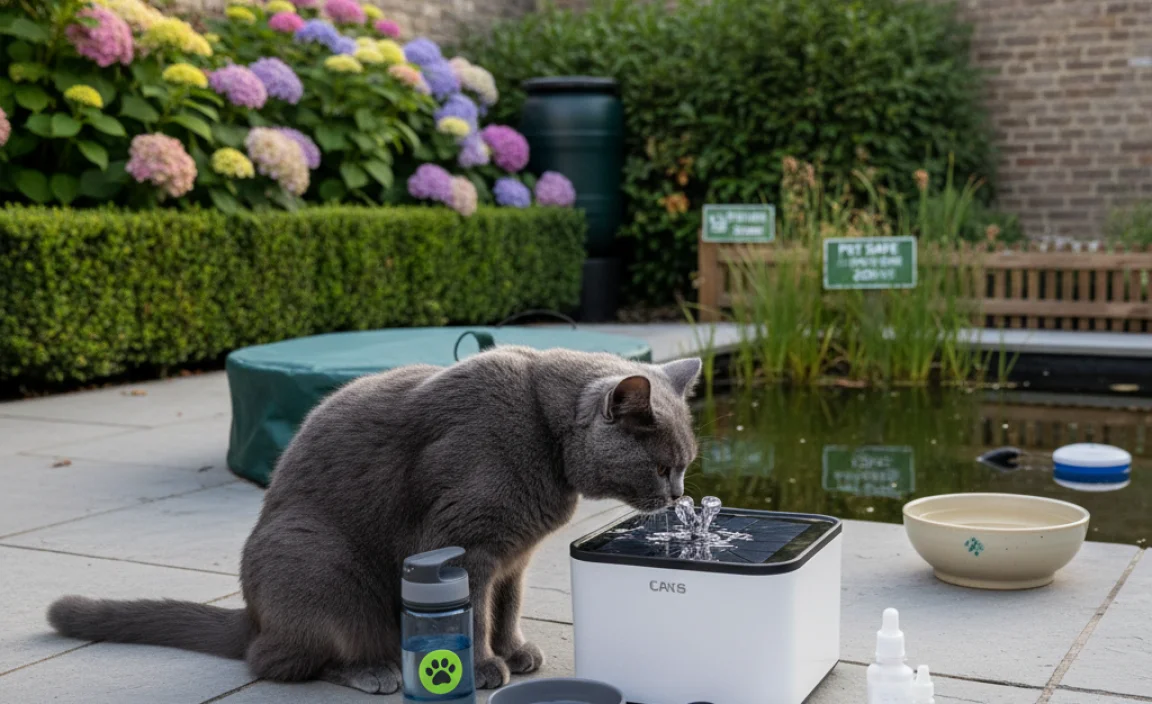
Investing in the right safety products can significantly reduce the risks associated with outdoor water sources.
| Product | Description | Benefits |
|---|---|---|
| Pool Safety Cover | A strong, fitted cover that prevents cats from falling into the pool. | Prevents drowning, keeps pool clean. |
| Cat Fence | A fence designed to keep cats in a designated area. | Prevents access to unsafe water sources, provides a secure outdoor space. |
| Cat Leash and Harness | Allows you to safely walk your cat outdoors. | Provides control, prevents wandering, allows for safe exploration. |
| Motion-Activated Sprinkler | A sprinkler that activates when motion is detected. | Deters cats from entering restricted areas. |
| Pet Water Fountain | Provides a continuous supply of fresh, filtered water. | Encourages hydration, reduces the temptation to drink from other sources. |
British Shorthairs and Water: Understanding Their Preferences
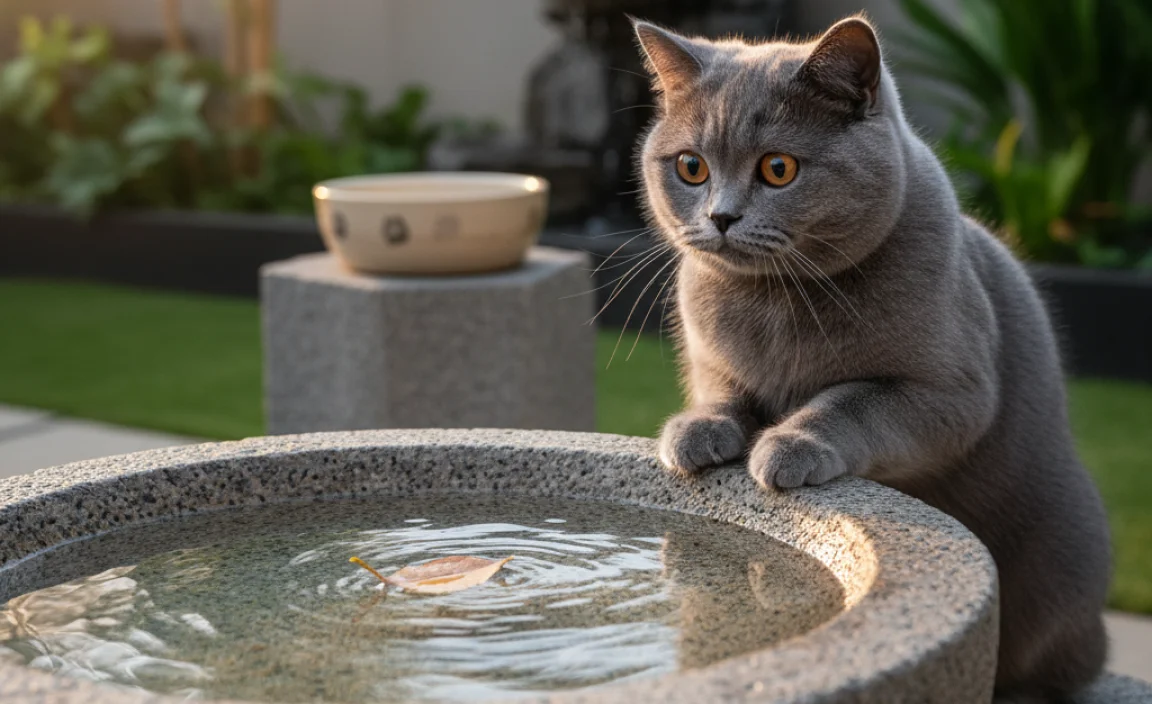
British Shorthairs generally aren’t known for being water-loving cats, but their curiosity can sometimes lead them to water sources. Understanding their typical behavior can help you anticipate and prevent potential problems.
Typical Behavior Around Water
Most British Shorthairs have a cautious approach to water:
- Avoidance: Many British Shorthairs avoid getting wet and will steer clear of puddles and other water sources.
- Curiosity: Some may be curious about water, dipping a paw in or watching water flow from a tap.
- Hesitation: They are less likely than some other breeds to jump into water or swim voluntarily.
Encouraging Safe Hydration
Encourage your British Shorthair to drink from their water bowl by making it appealing:
- Placement: Place the water bowl in a quiet, accessible location away from their food bowl.
- Freshness: Change the water daily and clean the bowl regularly.
- Type of Bowl: Some cats prefer ceramic or stainless-steel bowls over plastic.
- Water Temperature: Experiment with water temperature. Some cats prefer cool water, while others prefer room temperature.
- Pet Water Fountain: Consider a pet water fountain, as the moving water can be more enticing.
First-Aid Kit Essentials for Outdoor Water Exposure
Having a well-stocked first-aid kit can help you respond quickly and effectively to water-related emergencies.
Essential Items
Your first-aid kit should include:
- Sterile Gauze: For cleaning wounds and controlling bleeding.
- Antiseptic Solution: Such as diluted povidone-iodine, for disinfecting cuts and scrapes.
- Pet-Safe Soap: For washing off contaminants.
- Towel: For drying and warming your cat.
- Tweezers: For removing debris or splinters.
- Eye Wash: A sterile saline solution for flushing out irritated eyes.
- Hydrogen Peroxide (3%): To induce vomiting if instructed by a veterinarian or poison control center (use with caution and only under professional guidance).
- Pet Carrier: For safe transport to the vet.
- Contact Information: Your veterinarian’s phone number, the ASPCA Animal Poison Control Center number, and the nearest emergency veterinary clinic number.
Administering First Aid
Here are some basic first-aid steps you can take:
- Cleaning Wounds: Gently clean any wounds with antiseptic solution and cover with sterile gauze.
- Flushing Eyes: Flush irritated eyes with sterile eye wash.
- Removing Contaminants: Wash off any potential contaminants with pet-safe soap and water.
- Inducing Vomiting: Only induce vomiting if instructed by a veterinarian or poison control center. Use hydrogen peroxide (3%) at a dose of 1 teaspoon per 5 pounds of body weight. Monitor your cat closely and seek immediate veterinary attention.
FAQ: Keeping Your British Shorthair Safe Around Outdoor Water
Here are some frequently asked questions about outdoor water safety for British Shorthairs:
Q: Is it safe for my British Shorthair to drink from puddles?
A: No, it’s not safe. Puddles can contain bacteria, parasites, chemicals, and other contaminants that can make your cat sick. Always provide fresh, clean water in a bowl.
Q: How can I keep my cat from falling into the pool?
A: Use a pool safety cover when the pool is not in use and consider installing a pool fence. Teach your cat to stay away from the pool area using deterrents like motion-activated sprinklers.
Q: What are the signs of blue-green algae poisoning in cats?
A: Signs include vomiting, diarrhea, weakness, tremors, seizures, and difficulty breathing. Contact your vet immediately if you suspect algae poisoning.
Q: Can cats get water intoxication?
A: Yes, cats can get water intoxication if they drink too much water too quickly. Symptoms include vomiting, lethargy, dilated pupils, and seizures. Seek immediate veterinary care.
Q: Is it okay to let my cat play in the sprinkler?
A: While some cats enjoy playing in sprinklers, be cautious. Ensure the water source is clean and free of chemicals. Monitor your cat to prevent them from drinking too much water.
Q: What should I do if my cat falls into a pond?
A: Remove your cat from the water immediately. Check for breathing and perform rescue breathing if necessary. Wrap your cat in a warm towel and seek veterinary attention to rule out aspiration pneumonia.
Q: Are bird baths safe for cats?
A: Bird baths can be a source of contaminated water. Clean them regularly or, better yet, prevent your cat from accessing them by covering or removing them.
Conclusion
Protecting your British Shorthair from the dangers of outdoor water sources requires vigilance, preparation, and a proactive approach. By providing fresh water, securing water hazards, monitoring water quality, and supervising outdoor activities, you can create a safe and enjoyable environment for your feline friend. Remember to recognize the signs of water intoxication and poisoning and to have a well-stocked first-aid kit on hand. With these measures in place, you can rest assured that your British Shorthair can explore the outdoors safely and happily. After all, a well-informed and caring owner is the best safeguard for a beloved pet.



